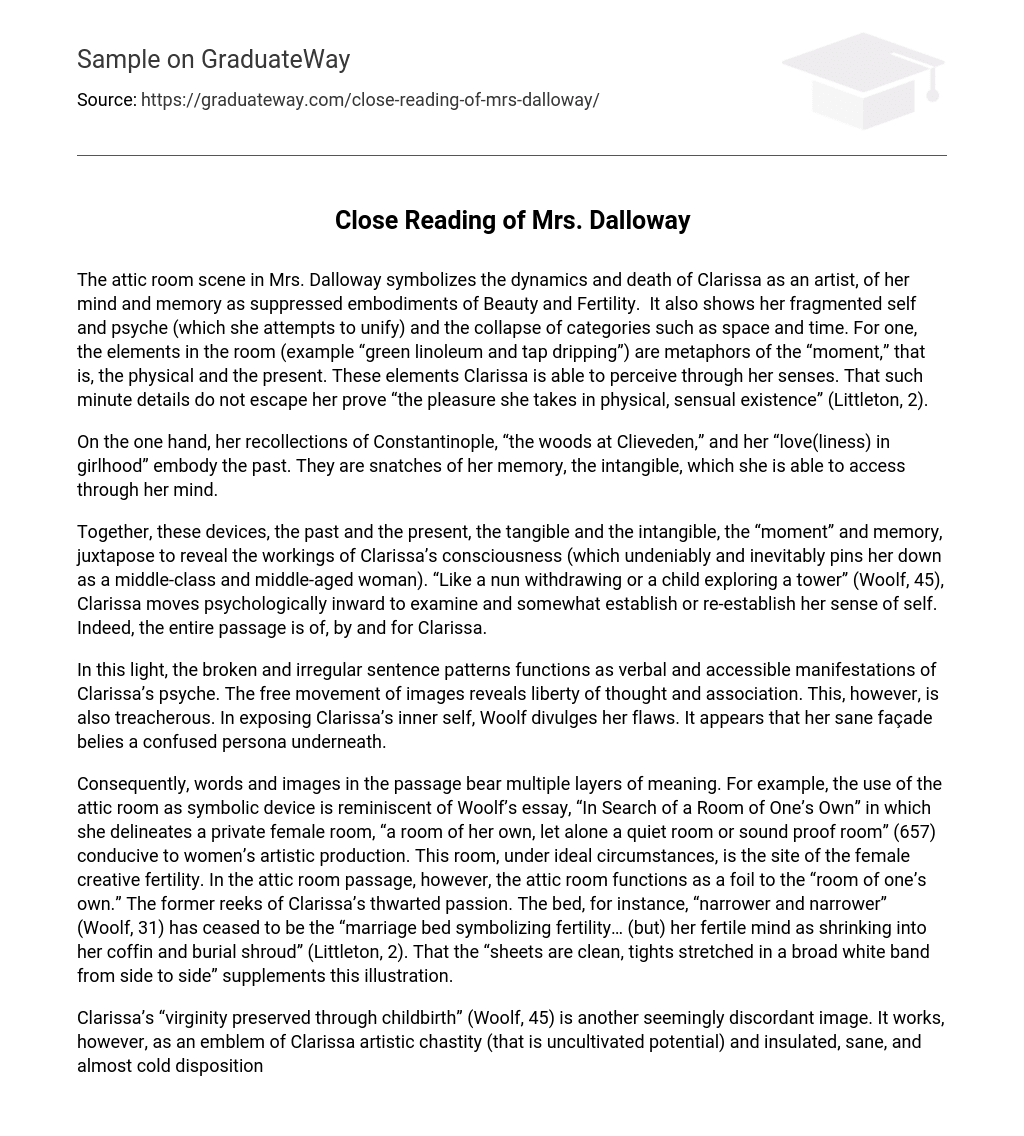The attic room scene in Mrs. Dalloway symbolizes the dynamics and death of Clarissa as an artist, of her mind and memory as suppressed embodiments of Beauty and Fertility. It also shows her fragmented self and psyche (which she attempts to unify) and the collapse of categories such as space and time. For one, the elements in the room (example “green linoleum and tap dripping”) are metaphors of the “moment,” that is, the physical and the present. These elements Clarissa is able to perceive through her senses. That such minute details do not escape her prove “the pleasure she takes in physical, sensual existence” (Littleton, 2).
On the one hand, her recollections of Constantinople, “the woods at Clieveden,” and her “love(liness) in girlhood” embody the past. They are snatches of her memory, the intangible, which she is able to access through her mind.
Together, these devices, the past and the present, the tangible and the intangible, the “moment” and memory, juxtapose to reveal the workings of Clarissa’s consciousness (which undeniably and inevitably pins her down as a middle-class and middle-aged woman). “Like a nun withdrawing or a child exploring a tower” (Woolf, 45), Clarissa moves psychologically inward to examine and somewhat establish or re-establish her sense of self. Indeed, the entire passage is of, by and for Clarissa.
In this light, the broken and irregular sentence patterns functions as verbal and accessible manifestations of Clarissa’s psyche. The free movement of images reveals liberty of thought and association. This, however, is also treacherous. In exposing Clarissa’s inner self, Woolf divulges her flaws. It appears that her sane façade belies a confused persona underneath.
Consequently, words and images in the passage bear multiple layers of meaning. For example, the use of the attic room as symbolic device is reminiscent of Woolf’s essay, “In Search of a Room of One’s Own” in which she delineates a private female room, “a room of her own, let alone a quiet room or sound proof room” (657) conducive to women’s artistic production. This room, under ideal circumstances, is the site of the female creative fertility. In the attic room passage, however, the attic room functions as a foil to the “room of one’s own.” The former reeks of Clarissa’s thwarted passion. The bed, for instance, “narrower and narrower” (Woolf, 31) has ceased to be the “marriage bed symbolizing fertility… (but) her fertile mind as shrinking into her coffin and burial shroud” (Littleton, 2). That the “sheets are clean, tights stretched in a broad white band from side to side” supplements this illustration.
Clarissa’s “virginity preserved through childbirth” (Woolf, 45) is another seemingly discordant image. It works, however, as an emblem of Clarissa artistic chastity (that is uncultivated potential) and insulated, sane, and almost cold disposition left intact by a male-imposed role.
Images of the “nun withdrawing” and “child exploring a tower” (Woolf, 45) also appear contradictory. The former carries a sense of deliberate isolation. The latter signifies curiosity and wonder. The child, though also in retreat as she goes up the tower, does not appear to completely withdraw herself from society. There is also a greater sense of mobility, physical and mental, in the use of the word “explore” as compared to the word “withdraw.”
Through the stream of consciousness technique, the passage becomes a monologue, or better yet, Clarissa’s dialogue with the other side of her personality and existence.
Although the attic room scene abounds with contradictions, the themes and literary elements used stand. It is a pluralistic whole, in the same way that the character it contains is a multi-faceted one.
Works Cited
- Littleton, Jacob. “Mrs. Dalloway: Portrait of the Artist as a Middle-aged Woman—novel by
- Virginia Woolf.” Twentieth Century Literature. Spring, 1995. < http://findarticles.com>. 07 November 2007.
- Woolf, Virginia. “In Search of a Room of One’s Own.” The Norton Reader. 7th ed. Eds. Arthur Eastman et al. New York: Norton, 1988. 650-661.
- Mrs. Dalloway. 1925. New York: Harvest Books, 1953.





